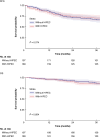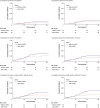Adjuvant hyperthermic intraperitoneal chemotherapy in patients with colon cancer at high risk of peritoneal metastases: individual patient data meta-analysis
- PMID: 40296220
- PMCID: PMC12037274
- DOI: 10.1093/bjs/znaf076
Adjuvant hyperthermic intraperitoneal chemotherapy in patients with colon cancer at high risk of peritoneal metastases: individual patient data meta-analysis
Abstract
Background: About a quarter of patients with locally advanced colon cancer (pT4) develop locoregional recurrence, including peritoneal metastases. The aim of this individual patient data meta-analysis (IPDMA) was to evaluate the efficacy of adjuvant hyperthermic intraperitoneal chemotherapy (HIPEC) with regard to reducing the locoregional recurrence rate in the overall population and high-risk subgroups of patients with locally advanced colon cancer.
Methods: A systematic literature search was conducted in July 2024 to identify RCTs on adjuvant HIPEC in addition to routine adjuvant systemic chemotherapy in locally advanced colon carcinoma. An IPDMA was performed, with the locoregional recurrence rate as the primary endpoint and disease-free survival (DFS) and overall survival (OS) as secondary endpoints.
Results: The search identified two trials (COLOPEC and HIPECT4). Individual patient data were pooled for 386 patients, of whom 189 patients received adjuvant HIPEC and 197 patients constituted the control group. The median follow-up was 36 (interquartile range 32-60) months. A modified intention-to-treat analysis showed a 36-month locoregional recurrence rate of 16.0% for HIPEC patients and 21.2% for control patients (P = 0.295). Predefined subgroup analyses revealed a significant reduction in locoregional recurrence after HIPEC in patients with right-sided tumours (HR 0.56 (95% c.i. 0.48 to 0.67)) (P < 0.001). No significant differences in survival were found for the overall study population; low event rates in subgroups did not allow for survival analyses.
Conclusion: Adjuvant HIPEC significantly reduced the locoregional recurrence rate in right-sided locally advanced colon cancer, but not in the overall study population. Definitive conclusions on DFS and OS require longer follow-up.
Plain language summary
Colon cancer can recur in the belly after surgery. Giving chemotherapy into the bloodstream does not seem to help this problem. The goal was to see if a rinse of the belly with heated chemotherapy (HIPEC) could lower the chances of cancer coming back in the belly of patients with colon cancer. Researchers looked at data from two studies, together involving 386 patients. About half of the patients received HIPEC, whereas the other patients did not. The researchers compared how often the cancer came back and how long patients lived without the disease. HIPEC lowered the chance of recurrence in the belly in patients with cancer in the right side of the colon. This was not found for patients with cancer in the left side of the colon. More research on this topic is necessary.
© The Author(s) 2025. Published by Oxford University Press on behalf of BJS Foundation Ltd.
Figures




References
-
- Bray F, Laversanne M, Sung H, Ferlay J, Siegel RL, Soerjomataram I et al. Global cancer statistics 2022: GLOBOCAN estimates of incidence and mortality worldwide for 36 cancers in 185 countries. CA Cancer J Clin 2024;74:229–263 - PubMed
-
- Franko J, Shi Q, Meyers JP, Maughan TS, Adams RA, Seymour MT et al. Prognosis of patients with peritoneal metastatic colorectal cancer given systemic therapy: an analysis of individual patient data from prospective randomised trials from the Analysis and Research in Cancers of the Digestive System (ARCAD) database. Lancet Oncol 2016;17:1709–1719 - PubMed
-
- van Gestel YR, de Hingh IH, van Herk-Sukel MP, van Erning FN, Beerepoot LV, Wijsman JH et al. Patterns of metachronous metastases after curative treatment of colorectal cancer. Cancer Epidemiol 2014;38:448–454 - PubMed
-
- Segelman J, Granath F, Holm T, Machado M, Mahteme H, Martling A. Incidence, prevalence and risk factors for peritoneal carcinomatosis from colorectal cancer. Br J Surg 2012;99:699–705 - PubMed
-
- van Gestel YR, Thomassen I, Lemmens VE, Pruijt JF, van Herk-Sukel MP, Rutten HJ et al. Metachronous peritoneal carcinomatosis after curative treatment of colorectal cancer. Eur J Surg Oncol 2014;40:963–969 - PubMed
Publication types
MeSH terms
Grants and funding
LinkOut - more resources
Full Text Sources
Medical

